Overview of Korean Number Systems
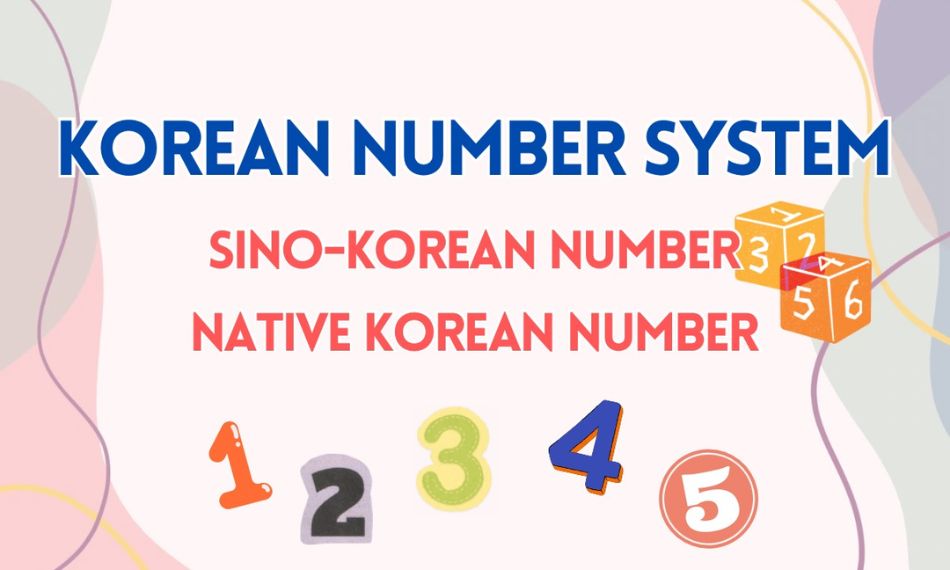
For beginners, earning numbers in Korean is as important as learning common Korean words and phrases. One of the first things to know is that there are two main number systems: Sino-Korean numbers and Native Korean numbers.
| Feature | Sino-Korean Number System (한자어 수 / Hanja-eo su) | Native Korean Number System (고유어 수 / Goyu-eo su) |
| Origin | Derived from Chinese characters (Hanja) | Purely Korean, without Chinese influence |
| Used for | Dates, money, addresses, phone numbers, minutes, age (formal) | Counting people, objects, age (informal), and hours |
| Pattern for Larger Numbers | Built in tens, hundreds, thousands (e.g., 20 = 이십 i-sip) | Built up to 99 (e.g., 20 = 스물 seumul) |
| Used in | Mathematics, prices, time (minutes), measurements | Counting things (like apples, books), people, and time (hours) |
| Example Usage | 전화번호: 010-이삼사-오육칠팔 (Phone number) | 사람 두 명 (two people), 사과 다섯 개 (five apples) |
In short, Sino-Korean numbers are more common in official or mathematical contexts, while Native Korean numbers are used in everyday life when counting or telling time in a casual way.
Basic Counting Numbers in Korean
When it comes to counting numbers in Korean, we usually focus on the Native Korean number system. These numbers are often used to count people, objects, and hours in daily life.
What is the number zero in Korean?
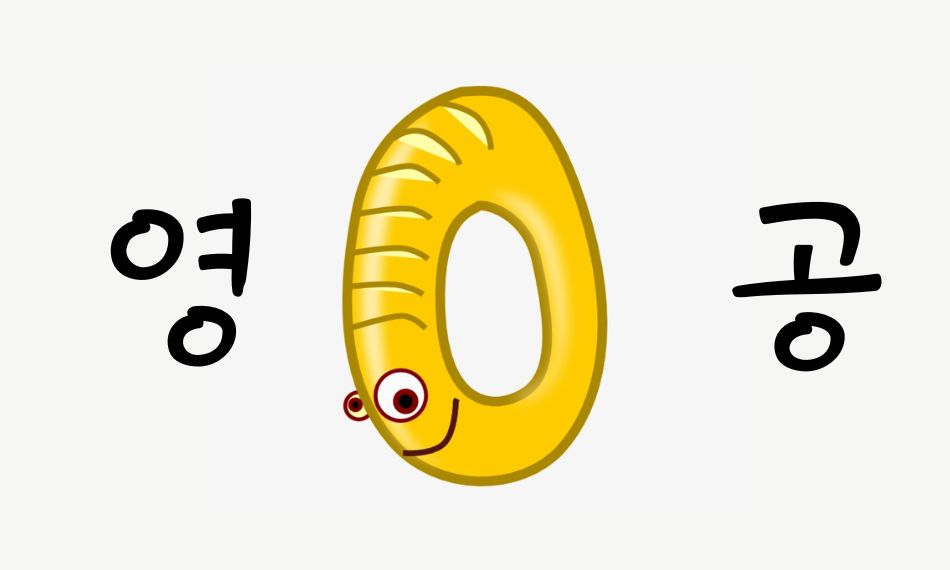
In Korean, the number “zero” can actually be said in two different ways, and both come from the Sino-Korean number system.
- 영 (yeong) – the most common word for “zero.”
- 공 (gong) – also means “zero,” but it’s used in special cases, like reading phone numbers or sports scores.
For example:
- 010-1234-5678 → 공일공-일이삼사-오육칠팔
- A score of 3-0 → 삼 대 영 (3-0)
There is no Native Korean word for zero, because Native Korean numbers are used for counting things, and you usually don’t count “zero apples” or “zero books.”
From 1 to 10
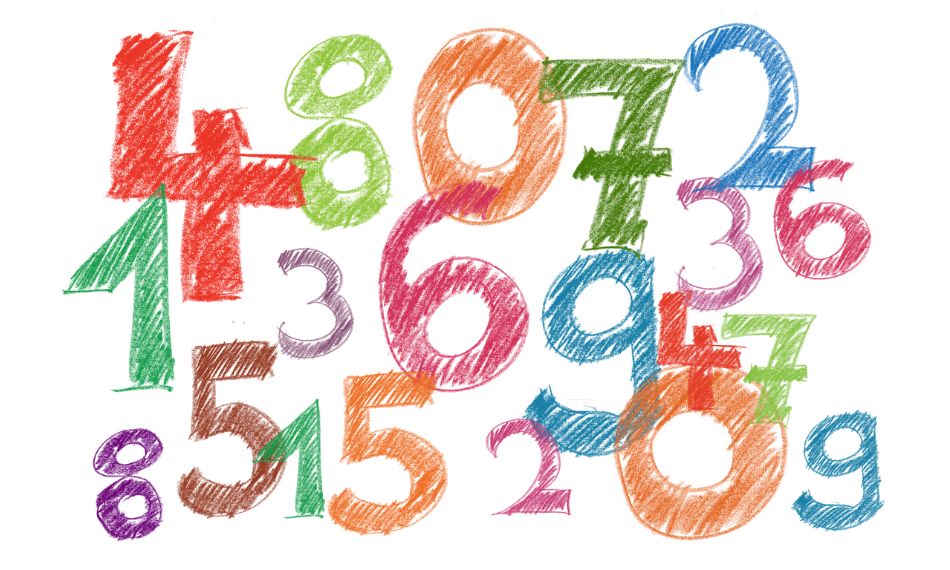
Let’s start with the basic Native Korean numbers from 1 to 10:
| Number | Native Korean Number |
| 1 | 하나 (hana) |
| 2 | 둘 (dul) |
| 3 | 셋 (set) |
| 4 | 넷 (net) |
| 5 | 다섯 (daseot) |
| 6 | 여섯 (yeoseot) |
| 7 | 일곱 (ilgop) |
| 8 | 여덟 (yeodeol) |
| 9 | 아홉 (ahop) |
| 10 | 열 (yeol) |
From 11 to 19

To form numbers from 11 to 19 in Native Korean, you simply follow a clear pattern: “열” (yeol), which means ten, is placed before the number from 1 to 9. So, it’s basically “ten + number”, just like saying “ten-one,” “ten-two,” and so on.
| Number | Native Korean Number |
| 11 | 열하나 (yeol-hana) |
| 12 | 열둘 (yeol-dul) |
| 13 | 열셋 (yeol-set) |
| 14 | 열넷 (yeol-net) |
| 15 | 열다섯 (yeol-daseot) |
| 16 | 열여섯 (yeol-yeoseot) |
| 17 | 열일곱 (yeol-ilgop) |
| 18 | 열여덟 (yeol-yeodeol) |
| 19 | 열아홉 (yeol-ahop) |
From 20 to 99
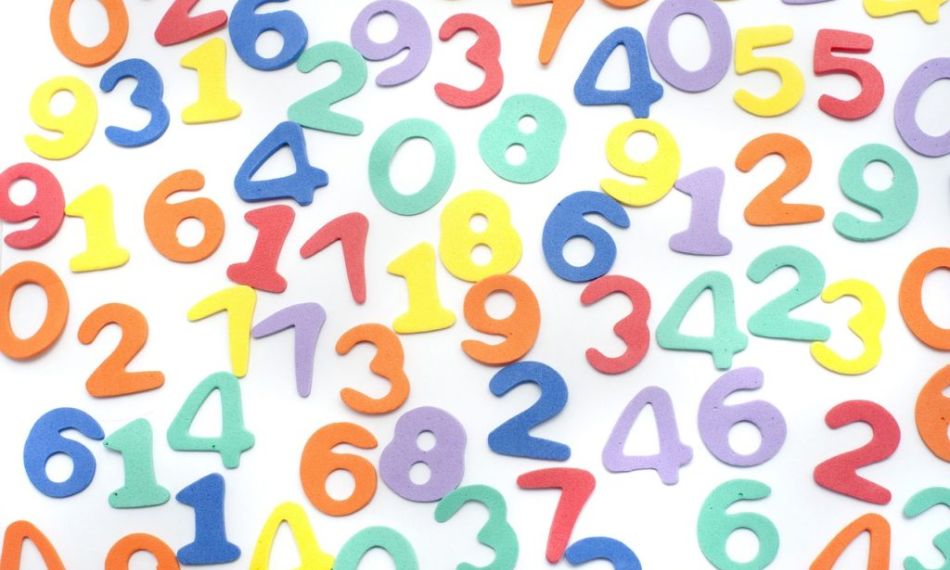
After 19, Korean uses unique words for each “tens” group (20, 30, 40, etc.). To form numbers like 21, 35, or 68, just combine the “tens” word with the smaller number (1-9).
| Number | Native Korean Number |
| 20 | 스물 (seumul) |
| 21 | 스물하나 (seumul-hana) |
| 22 | 스물둘 (seumul-dul) |
| 23 | 스물셋 (seumul-set) |
| 24 | 스물넷 (seumul-net) |
| 25 | 스물다섯 (seumul-daseot) |
| 26 | 스물여섯 (seumul-yeoseot) |
| 27 | 스물이곱 (seumul-ilgop) |
| 28 | 스물여덟 (seumul-yeodeol) |
| 29 | 스물아홉 (seumul-ahop) |
| 30 | 서른 (seoreun) |
| 31 | 서른하나 (seoreun-hana) |
| 32 | 서른둘 (seoreun-dul) |
| 33 | 서른셋 (seoreun-set) |
| 34 | 서른넷 (seoreun-net) |
| 35 | 서른다섯 (seoreun-daseot) |
| 36 | 서른여섯 (seoreun-yeoseot) |
| 37 | 서른일곱 (seoreun-ilgop) |
| 38 | 서른여덟 (seoreun-yeodeol) |
| 39 | 서른아홉 (seoreun-ahop) |
| 40 | 마흔 (maheun) |
| 41 | 마흔하나 (maheun-hana) |
| 42 | 마흔둘 (maheun-dul) |
| 43 | 마흔셋 (maheun-set) |
| 44 | 마흔넷 (maheun-net) |
| 45 | 마흔다섯 (maheun-daseot) |
| 46 | 마흔여섯 (maheun-yeoseot) |
| 47 | 마흔일곱 (maheun-ilgop) |
| 48 | 마흔여덟 (maheun-yeodeol) |
| 49 | 마흔아홉 (maheun-ahop) |
| 50 | 쉰 (swin) |
| 51 | 쉰하나 (swin-hana) |
| 52 | 쉰둘 (swin-dul) |
| 53 | 쉰셋 (swin-set) |
| 54 | 쉰넷 (swin-net) |
| 55 | 쉰다섯 (swin-daseot) |
| 56 | 쉰여섯 (swin-yeoseot) |
| 57 | 쉰일곱 (swin-ilgop) |
| 58 | 쉰여덟 (swin-yeodeol) |
| 59 | 쉰아홉 (swin-ahop) |
| 60 | 예순 (yesun) |
| 61 | 예순하나 (yesun-hana) |
| 62 | 예순둘 (yesun-dul) |
| 63 | 예순셋 (yesun-set) |
| 64 | 예순넷 (yesun-net) |
| 65 | 예순다섯 (yesun-daseot) |
| 66 | 예순여섯 (yesun-yeoseot) |
| 67 | 예순일곱 (yesun-ilgop) |
| 68 | 예순여덟 (yesun-yeodeol) |
| 69 | 예순아홉 (yesun-ahop) |
| 70 | 일흔 (ilheun) |
| 71 | 일흔하나 (ilheun-hana) |
| 72 | 일흔둘 (ilheun-dul) |
| 73 | 일흔셋 (ilheun-set) |
| 74 | 일흔넷 (ilheun-net) |
| 75 | 일흔다섯 (ilheun-daseot) |
| 76 | 일흔여섯 (ilheun-yeoseot) |
| 77 | 일흔일곱 (ilheun-ilgop) |
| 78 | 일흔여덟 (ilheun-yeodeol) |
| 79 | 일흔아홉 (ilheun-ahop) |
| 80 | 여든 (yeodeun) |
| 81 | 여든하나 (yeodeun-hana) |
| 82 | 여든둘 (yeodeun-dul) |
| 83 | 여든셋 (yeodeun-set) |
| 84 | 여든넷 (yeodeun-net) |
| 85 | 여든다섯 (yeodeun-daseot) |
| 86 | 여든여섯 (yeodeun-yeoseot) |
| 87 | 여든일곱 (yeodeun-ilgop) |
| 88 | 여든여덟 (yeodeun-yeodeol) |
| 89 | 여든아홉 (yeodeun-ahop) |
| 90 | 아흔 (aheun) |
| 91 | 아흔하나 (aheun-hana) |
| 92 | 아흔둘 (aheun-dul) |
| 93 | 아흔셋 (aheun-set) |
| 94 | 아흔넷 (aheun-net) |
| 95 | 아흔다섯 (aheun-daseot) |
| 96 | 아흔여섯 (aheun-yeoseot) |
| 97 | 아흔일곱 (aheun-ilgop) |
| 98 | 아흔여덟 (aheun-yeodeol) |
| 99 | 아흔아홉 (aheun-ahop) |
Ordinal numbers in Korean
When learning ordinal numbers in Korean, you’ll see two common ways to express order: One with native Korean numbers + 번째 (beonjjae) for daily situations, and another with 제 (je) + Sino-Korean numbers for formal contexts. Ordinal numbers are used to describe positions or ranks, like “first,” “second,” or “third.”
Everyday Use Of Ordinal Numbers In Korean
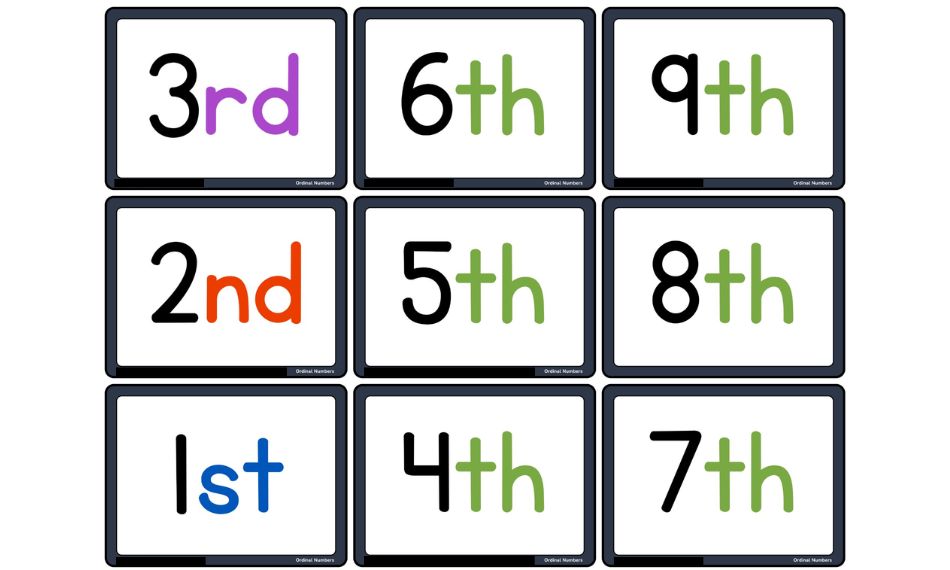
In most conversations, Koreans use native numbers followed by 번째 (beonjjae) to form ordinal numbers.
| English | Korean |
| 1st | 첫 번째 (cheot beonjjae) |
| 2nd | 두 번째 (du beonjjae) |
| 3rd | 세 번째 (se beonjjae) |
| 4th | 네 번째 (ne beonjjae) |
| 5th | 다섯 번째 (daseot beonjjae) |
| 6th | 여섯 번째 (yeoseot beonjjae) |
| 7th | 일곱 번째 (ilgop beonjjae) |
| 8th | 여덟 번째 (yeodeol beonjjae) |
| 9th | 아홉 번째 (ahop beonjjae) |
| 10th | 열 번째 (yeol beonjjae) |
| 20th | 스무 번째 (seumu beonjjae) |
| 30th | 서른 번째 (seoreun beonjjae) |
| 40th | 마흔 번째 (maheun beonjjae) |
| 50th | 쉰 번째 (swin beonjjae) |
| 60th | 예순 번째 (yesun beonjjae) |
| 70th | 일흔 번째 (ilheun beonjjae) |
| 80th | 여든 번째 (yeodeun beonjjae) |
| 90th | 아흔 번째 (aheun beonjjae) |
Note: The first ordinal number is a bit more special. Instead of 하나 번째 (hana beonjjae), Koreans use 첫 번째 (cheot beonjjae).
Formal Use Of Ordinal Numbers In Korean

In more formal or written contexts (books, floors, chapters, competitions), ordinal numbers in Koreans use 제 (je) followed by a Sino-Korean number.
| English | Korean |
| 1st | 제일 (je-il) |
| 2nd | 제이 (je-i) |
| 3rd | 제삼 (je-sam) |
| 4th | 제사 (je-sa) |
| 5th | 제오 (je-o) |
| 6th | 제육 (je-yuk) |
| 7th | 제칠 (je-chil) |
| 8th | 제팔 (je-pal) |
| 9th | 제구 (je-gu) |
| 10th | 제십 (je-sip) |
| 20th | 제이십 (je-i-sip) |
| 30th | 제삼십 (je-sam-sip) |
| 40th | 제사십 (je-sa-sip) |
| 50th | 제오십 (je-o-sip) |
| 60th | 제육십 (je-yuk-sip) |
| 70th | 제칠십 (je-chil-sip) |
| 80th | 제팔십 (je-pal-sip) |
| 90th | 제구십 (je-gu-sip) |
| 100th | 제백 (je-baek) |
| 1000th | 제천 (je-cheon) |
Conclusion
Understanding numbers in Korean is one of the first and most practical steps for beginners. Once you know the difference between Native Korean and Sino-Korean number systems, it becomes much easier to count, tell time, talk about money, or even read phone numbers confidently.
Ready to take your next step in mastering Korean? Start your journey today and learn Korean with GuruLango!
FAQs
1. How do you say 1, 2, 3, 4, 5, 6, 7, 8, 9, 10 in Korean?
In Korean, there are two systems. The Native Korean numbers are 하나 (hana), 둘 (dul), 셋 (set), 넷 (net), 다섯 (daseot), 여섯 (yeoseot), 일곱 (ilgop), 여덟 (yeodeol), 아홉 (ahop), and 열 (yeol). The Sino-Korean numbers are 일 (il), 이 (i), 삼 (sam), 사 (sa), 오 (o), 육 (yuk), 칠 (chil), 팔 (pal), 구 (gu), and 십 (sip).
2. How to write 1 to 100 in Korean?
For numbers from 1 to 100, use Native Korean for 1-99 (하나 to 아흔아홉) and Sino-Korean from 100 (백, baek) onward.
3. How to count to 30 in Korean?
Count with Native Korean numbers: 하나 (1) to 열 (10), then 열하나 (11) to 열아홉 (19), followed by 스물 (20) to 서른 (30).
4. Is +82 a Korean number?
Yes, +82 is the country calling code for South Korea. If you are calling a Korean number from outside the country, you need to dial +82 first, and then omit the first zero of the local number.